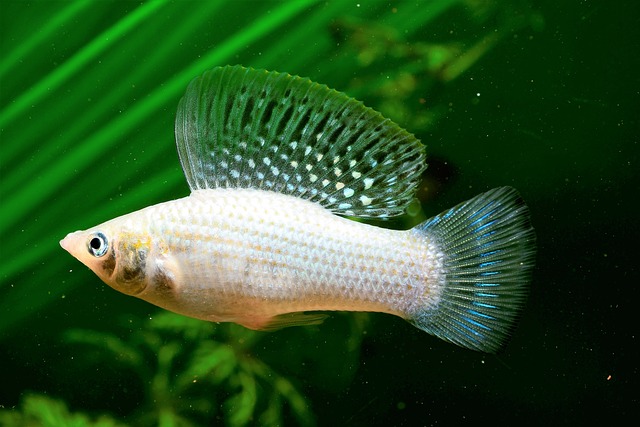
Molly
Scientific name: Poecilia sphenops
The Molly is a hardy, adaptable freshwater fish native to the freshwater and brackish waters of Central America, ranging from Mexico to Colombia. Renowned for its wide variety of colors, patterns, and fin shapes, the Molly adds vibrancy and diversity to any aquarium. They are peaceful, active swimmers that do well in community tanks with other non-aggressive species.
Their livebearing nature and ease of breeding make them a fascinating choice for aquarists interested in observing fish reproduction firsthand. Mollies are known for their hardiness and ability to adapt to various water conditions, making them suitable for both beginner and experienced fish keepers.
IUCN Red List of Threatened Species : Least Concern
Mollies are social fish that thrive when kept in groups of at least four or more. They are active throughout all levels of the aquarium, adding constant movement and interest to the tank. Providing them with a well-decorated aquarium that includes both open swimming spaces and planted areas enhances their environment and well-being.
As omnivores, they enjoy a varied diet that includes high-quality flake food, algae-based foods, and live or frozen foods like brine shrimp or bloodworms. Their peaceful demeanor makes them compatible with a wide variety of tank mates, including other livebearers and peaceful community fish.

Navite Location
Central America (Mexico to Colombia)
Varieties
Black / Sailfin / Balloon / Dalmatian / Gold Dust / Lyretail
Suggested Tank Mates
Guppies / Platies / Swordtails / Corydoras Catfish / Tetras (non-fin nippers) / Other peaceful community fish
Tank Mates to Avoid
Aggressive or fin-nipping fish / Large Cichlids / Tiger Barbs / Bettas (may be aggressive)
Diet
High-quality flake food / Algae-based foods / Live or frozen foods (brine shrimp, bloodworms) / Vegetables (blanched spinach, zucchini)
Breeding
Mollies are livebearers, giving birth to live, free-swimming young. Breeding is relatively easy, and females can produce 20 to 100 fry every 4 to 6 weeks under optimal conditions.
Lifespan
3 to 5 years with proper care
Size
Up to 12 cm (4.5 inches), depending on the species
Minimum Tank Size
20 gallons (75 liters) for a small group; larger tanks are recommended for sailfin varieties due to their size
Optimum Tank Temperature
24°C to 28°C (75°F to 82°F)
Ideal pH Level
7.5 to 8.5 (prefer slightly alkaline water)
Water Hardness
15 – 30 dGH (prefer hard water)
Common Health Issues
Ich (White Spot Disease) / Fin Rot / Fungal Infections / Internal Parasites / Columnaris (Livebearer Disease)
Interesting facts
They Can Tolerate Brackish Water
Mollies have the unique ability to thrive in both freshwater and brackish water environments. In the wild, they often inhabit areas where freshwater meets seawater, such as estuaries and coastal lagoons.
Prolific Breeders
Mollies are known for their high reproduction rate. Females can store sperm and continue to give birth multiple times from a single mating, producing several broods over a few months.
Variety of Colors and Fin Shapes
Through selective breeding, mollies are available in a wide range of colors and fin types, including the elegant sailfin and lyretail varieties, as well as the uniquely shaped balloon molly.
Sensitive to Water Quality
Despite their hardiness, mollies are sensitive to poor water conditions. They require clean, well-filtered water and benefit from regular water changes to prevent health issues.
Sexual Dimorphism
Males and females are easily distinguishable. Males are generally smaller with more elaborate dorsal fins and a gonopodium, a modified anal fin used for reproduction. Females are larger with a rounder body shape, especially when gravid.
Molly FAQ’s
Do Mollies Need Salt in Their Water?
While mollies can tolerate and sometimes thrive in brackish conditions, adding salt to a freshwater aquarium is not strictly necessary unless treating specific health issues. Always consult care guidelines before altering water salinity.
Can Mollies Live with Other Livebearers?
Yes, mollies are compatible with other peaceful livebearers like guppies, platies, and swordtails. They share similar care requirements and temperaments, making them excellent tank mates.
How Can I Tell if My Molly Is Pregnant?
A pregnant molly will have a noticeably enlarged abdomen and may develop a dark gravid spot near the anal fin. She may also become less active and seek shelter as she nears giving birth.
Do Mollies Eat Their Fry?
Yes, adult mollies may eat their own young if given the opportunity. Providing plenty of hiding places with plants or using a breeding box can help protect the fry until they are large enough to fend for themselves.
Do Molly Fish Prefer High or Low Water Flow?
Molly fish prefer low to moderate water flow in their aquarium environment. In the wild, mollies inhabit calm, slow-moving waters such as streams, ponds, and coastal brackish areas.
Providing a gentle water flow in your aquarium replicates their natural habitat and helps reduce stress.
At What Age Do Mollies Breed?
Mollies typically reach sexual maturity and are capable of breeding at around 3 to 4 months of age. This age can vary slightly depending on factors such as Diet, Water Conditions and Environmental Stressors.
Can Mollies Live with Goldfish?
While it might seem appealing to house mollies and goldfish together, it’s generally not recommended due to significant differences in their environmental requirements and behaviors.
